Politics
Estimated 16,500 climate change deaths during Europe summer: study
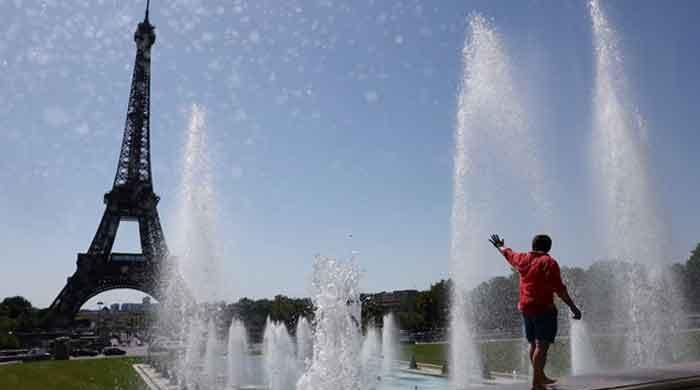
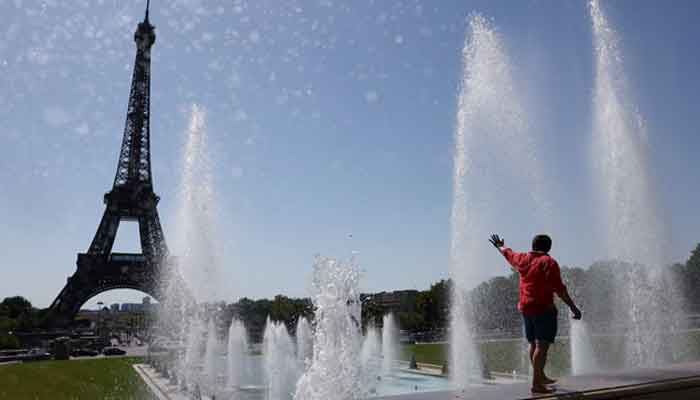
PARIS: Scientists estimated Wednesday that rising temperatures from human-caused climate change were responsible for roughly 16,500 deaths in European cities this summer, using modelling to project the toll before official data is released.
The rapidly-produced study is the latest effort by climate and health researchers to quickly link the death toll during heatwaves to global warming –without waiting months or years to be published in a peer–reviewed journal.
The estimated deaths were not actually recorded in the European cities, but instead were a projection based on methods such as modelling used in previously peer-reviewed studies.
Death tolls during heatwaves are thought to be vastly underestimated because the causes of death recorded in hospitals are normally heart, breathing or other health problems that particularly affect the elderly when the mercury soars.
To get a snapshot of this summer, a UK-based team of researchers used climate modelling to estimate that global warming made temperatures an average of 2.2 degrees Celsius hotter in 854 European cities between June and August.
Using historical data indicating how such soaring temperatures drive up mortality rates, the team estimated there were around 24,400 excess deaths in those cities during that time.
They then compared this number to how many people would have died in a world that was not 1.3C warmer due to climate change caused by humans burning fossil fuels.
Nearly 70% – 16,500 – of the estimated excess deaths were due to global warming, according to the rapid attribution study.
This means climate change could have tripled the number of heat deaths this summer, said the study from scientists at Imperial College London and epidemiologists at the London School of Hygiene & Tropical Medicine.
The team had previously used similar methods to find a similar result for a single European heatwave that started in late June.
The researchers said they were not able to compare their estimates to actual excess deaths recorded in European cities this summer because most countries take a long time to publish that data.
“It’s impossible to get real-time statistics right now,” however, the estimates are “in the right ballpark,” study co-author Friederike Otto told a press conference.
‘Even more alarming’
The estimates did reflect previous peer-reviewed research, such as a Nature Medicine study, which determined there were more than 47,000 heat-related deaths during the European summer of 2023.
Numerous prominent climate and health researchers also backed the study.
“What makes this finding even more alarming is that the methods used in these attribution studies are scientifically robust, yet conservative,” said atmospheric science researcher Akshay Deoras at the UK’s University of Reading.
“The actual death toll could be even higher.”
The study said that Rome had the most estimated deaths attributed to climate change, with 835, followed by Athens with 630 and Paris with 409.
More than 85% of the estimated excess deaths were among people aged 65 or over.
The researchers emphasised the study did not represent Europe as a whole because some areas — such as the Balkans — were not included.
“An increase in heatwave temperature of just 2-4C can be the difference between life and death for thousands of people — this is why heatwaves are known as silent killers,” study co-author Garyfallos Konstantinoudis said.
This year was Europe’s fourth-hottest summer on record.
Politics
Dick Cheney, powerful former US VP who pushed for Iraq war, dies at 84
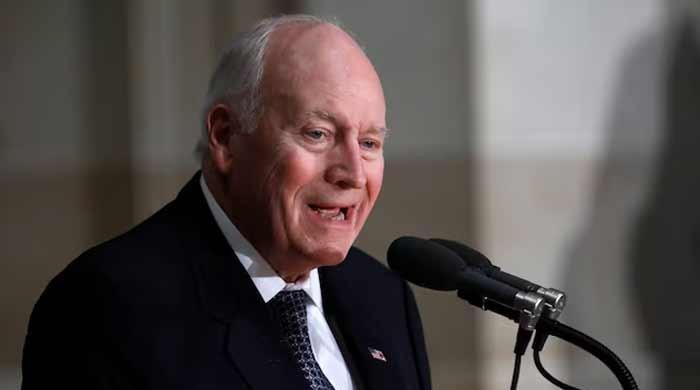

Dick Cheney, a driving force behind the US invasion of Iraq in 2003, who was considered by presidential historians as one of the most powerful vice presidents in US history, passed away at age 84, his family said on Tuesday.
In a statement, his family said that Cheney died on Monday from complications of pneumonia and cardiac and vascular disease.
The Republican — a former Wyoming congressman and secretary of defense — was already a major Washington player when then-Texas governor George W Bush chose him to be his running mate in the 2000 presidential race that Bush went on to win.
As vice president from 2001 to 2009, Cheney fought vigorously for an expansion of the power of the presidency, having felt that it had been eroding since the Watergate scandal that drove his one-time boss Richard Nixon from office.
He also expanded the clout of the vice president’s office by putting together a national security team that often served as a power center of its own within the administration.
Cheney was a strong advocate for the 2003 invasion of Iraq and was among the most outspoken of Bush administration officials warning of the danger from Iraq’s alleged stockpile of weapons of mass destruction. No such weapons were found.
He clashed with several top Bush aides, including Secretaries of State Colin Powell and Condoleezza Rice, and defended “enhanced” interrogation techniques of terrorism suspects that included waterboarding and sleep deprivation.
Others, including the US Senate Select Committee on Intelligence and the UN special rapporteur on counter terrorism and human rights, called these techniques “torture.”
His daughter Liz Cheney also became an influential Republican lawmaker, serving in the House of Representatives but losing her seat after opposing Republican President Donald Trump and voting to impeach him in the wake of the January 6, 2021 attack on the Capitol by his supporters. Her father, who agreed with her, said that he would vote for Democratic candidate Kamala Harris in 2024.
“In our nation’s 248 year-history, there has never been an individual who is a greater threat to our republic than Donald Trump,” said the man who had long been a foe of the left.
Cheney was troubled much of his life by heart problems, suffering the first of a number of heart attacks at age 37. He had a heart transplant in 2012.
Taking on Iraq
Cheney and Defense Secretary Donald Rumsfeld, who had been colleagues in the Nixon White House, were key voices pushing for the March 2003 invasion of Iraq.
In the run-up to the war, Cheney suggested there might be links between Iraq and al Qaeda and the September 11, 2001 attacks on the United States. A commission on the 9/11 attacks later discredited this theory.
Cheney predicted US forces would be “greeted as liberators” in Iraq and that the troop deployment — which would last around a decade — would “go relatively quickly … weeks rather than months.”
Although no weapons of mass destruction were found, Cheney in later years insisted that the invasion was the right decision based on the intelligence at the time and the removal of Iraqi President Saddam Hussein from power.
More than a decade earlier, as defense secretary under President George HW Bush, Cheney had directed the US military operation to expel an Iraqi occupation army from Kuwait in the first Gulf War.
He urged Bush senior to take an uncompromising line against Iraq after Saddam Hussein sent his troops to occupy Kuwait in August 1990. But at that point Cheney did not support an invasion of Iraq, saying the United States would have to act alone and that the situation would become a quagmire.
Because of Cheney’s long ties to the Bush family and experience in government, George W Bush chose him to head his vice presidential search in 2000. Bush then decided the man doing the search was the best candidate for the job.
Upon his re-entry into politics, Cheney received a $35 million retirement package from oil services firm Halliburton, which he had run from 1995 to 2000. Halliburton became a leading government contractor during the Iraq war. Cheney’s oil industry links were a subject of frequent criticism by opponents of the war.
First Republican in generations
Richard Bruce Cheney was born in Lincoln, Nebraska, to Marjorie Lorraine (née Dickey) and Richard Herbert Cheney on January 30, 1941, the day then-President Franklin Roosevelt turned 59. His mother was a waitress turned softball player, his father a federal worker with the Soil Conservation Service.
Both sides of the family were staunch New Deal Democrats, he wrote in his 2011 book “In My Time: A Personal and Political Memoir.”
Convinced that the president would want to know that he shared a birthday with the newborn, Cheney’s grandfather urged Marjorie and Richard to share the news by telegram with the White House.
In his family he “was the first Republican probably since my great-grandfather who fought in the Civil War on the Union side,” he told the PBS documentary “Dick Cheney: A Heartbeat Away.”
He moved as a boy to Wyoming with his family, before attending Yale University. “I was a mediocre student, at best,” he said. He dropped out.
Politics
UK partner terminates Arshad Khan ‘Chaiwala’ over contract violations


LONDON: A legal and branding dispute has surfaced between once viral sensation Arshad Khan — popularly known as blue-eyed Arshad Khan Chaiwala — and Nadir Durrani, the London-based businessman who helped introduce the Café Chaiwala brand to Britain.
The disagreement centres on the use of the Chaiwala name, payments and claims of independent brand development.
Arshad Khan first became a household name in 2016 after a photo of him making tea at an Islamabad stall went viral. Riding that wave of fame, he launched his original Chaiwala Café in October 2020. In March 2021, UK master franchise rights were granted to Nadir Durrani and Yawar Akbar Durrani under a 10-outlet master franchise agreement.
The first branch under this arrangement opened in East London, Ilford Lane, in 2023, followed by a sub-franchise in Tooting, South London, in early 2025 — both doing good business.
The case hinges on intellectual property rights and contract interpretation. Arshad says the UK partners have terminated him.
Speaking to Geo News, Nadir confirmed the UK operation has terminated its contract with the brand represented by Arshad. “We have parted our ways amicably. We will soon rebrand under a new name — to be revealed very soon. We are opening another outlet in Slough, West London, soon.”

He contends that what was originally presented as a franchise turned into a “self-built enterprise” as the UK team received “no operational, material, or marketing support from the franchise owner Kazim Hasan, and we had to design everything independently — from the logo and interior design to recipes and customer experience”.
He added that despite paying royalties faithfully, the UK business was left without the resources typically provided in a legitimate franchise system. “Everything that defines our cafés — the visuals, menu, and feel – was created here, not imported. We received no support from Arshad Khan’s team. He couldn’t come to the UK over his Afghan nationality matter. Every promise his team made turned out to be false.”
Nadir said, “Arshad Khan’s team played no part in our success. The café’s identity, menu, operations, and branding were not inherited from the franchiser but conceived and built entirely through my own creativity, experimentation and perseverance. I bore the financial burden, took all the risks, and did the foundational work typically done by a brand’s headquarters. Our success is based on our sheer personal dedication.”
Arshad claims that since early 2025, he has faced ongoing contractual and payment issues with his UK partners. He told this reporter he had not received royalty payments for over 10 months despite the cafés continuing to operate and “making good money”.
“They sent me a termination notice and stopped my payments,” Arshad claimed. “But they are still running the business under my brand name ‘Café Chaiwala’ — only removing ‘Arshad Khan’ from the branding. “This is my name, my identity, and my hard work. I just want justice.”
Nadir said: “Arshad Khan was not the franchisor but instead was managed by Kazim who was the actual franchisor who signed the agreement with us. When we signed the deal with Kazim, they had one flagship unit in Blue Area and more opening in Pakistan but they lost all their units due to poor performance. We sued them in Pakistan and have a favourable judgement with us. Arshad Khan’s troubles were never mentioned to us prior to signing the contract. We offered to buy the franchise outright but the franchisor didn’t cooperate.”
Arshad also said that he has now hired solicitors to pursue legal action and intends to travel to London following the unblocking of his CNIC — over the Afghan nationality issue, which was resolved last month.
In a statement, Kazim said: “The brand and its ownership remain solely under our franchise rights.”
Politics
New York City mayoral race goes to polls amid three-way contest
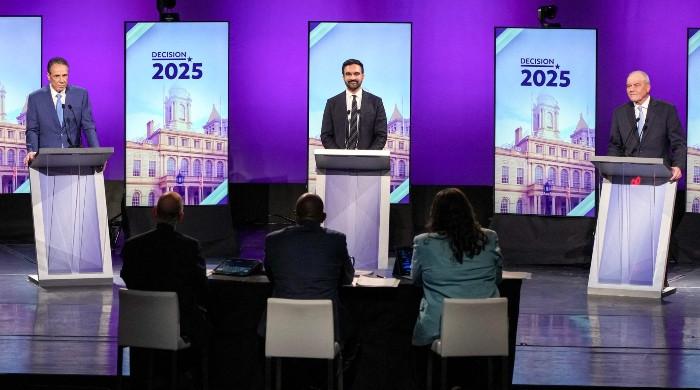
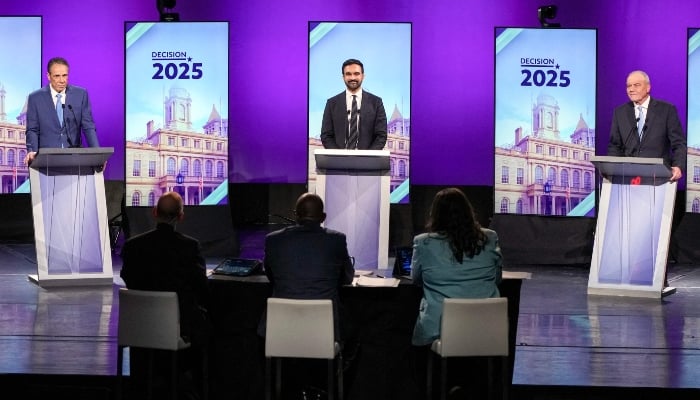
- Mamdani leads by 14.7 points in RCP average.
- 734,317 early ballots cast, quadruple 2021 count.
- Trump, Musk endorse Cuomo on election eve.
Voters in New York City will choose their next mayor on Tuesday, closing out an eventful campaign featuring Democrat Zohran Mamdani, independent Andrew Cuomo and Republican Curtis Sliwa
Early voting has ended, with 734,317 ballots cast over the past nine days, more than four times the 2021 tally, Al Jazeera reported, citing the New York City Board of Elections. As of the latest RealClearPolitics average, Mamdani leads on 45.8%, a 14.7-point advantage over Cuomo (31.1%) and a 28.5-point lead over Sliwa (17.3%).
Late on Monday, Donald Trump and Elon Musk endorsed Cuomo; it is unclear whether the last-minute backing will shift votes.
The race follows the withdrawal of incumbent Democrat Eric Adams, who left the contest on September 29 after poor polling. Adams, in office since January 2022, had faced controversies, including a federal criminal indictment on bribery and conspiracy charges that was later dismissed by a judge in April.
This year’s contest has drawn clear lines between progressive, establishment and conservative camps in the country’s largest city.
How the voting works
Unlike the city’s primaries, which used ranked-choice voting, the general election is first-past-the-post: the candidate with the most votes wins.
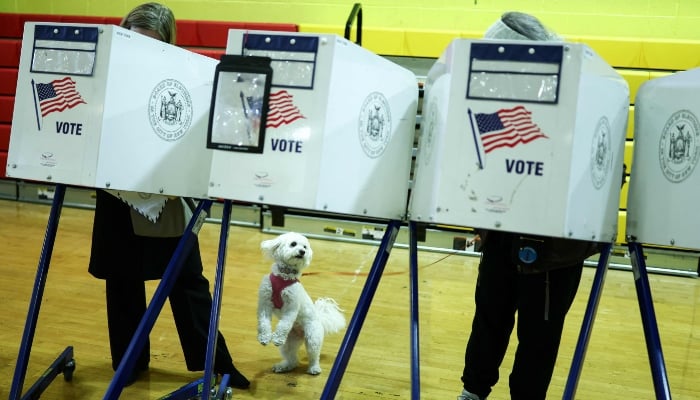
As of February, New York City had 5.1 million registered voters, about 65% Democrats, 11% Republicans and roughly 1.1 million unaffiliated.
Registration closed on October 25 for the November 4 vote. In the last mayoral election, just over 1.1 million ballots were cast (about 21% turnout).
To be eligible to vote, residents must be US citizens, 18 or older on election day (pre-registration at 16–17 permitted), New York City residents for at least 30 days, not in prison for a felony conviction, not adjudged mentally incompetent by a court, and not registered elsewhere.
Polling places are scheduled to open from 6am to 9pm on November 4; some local schedules vary, with openings from 8 to 10am and closings from 4 to 9pm. Early voting ran from October 25 to November 2; locations were listed by the city’s Board of Elections.
Who’s on the ballot
Zohran Mamdani, 34, the Democratic nominee and a New York State Assembly member for Astoria, has rallied liberal voters with proposals for universal free childcare, free buses and a rent freeze for roughly one million rent-regulated apartments.
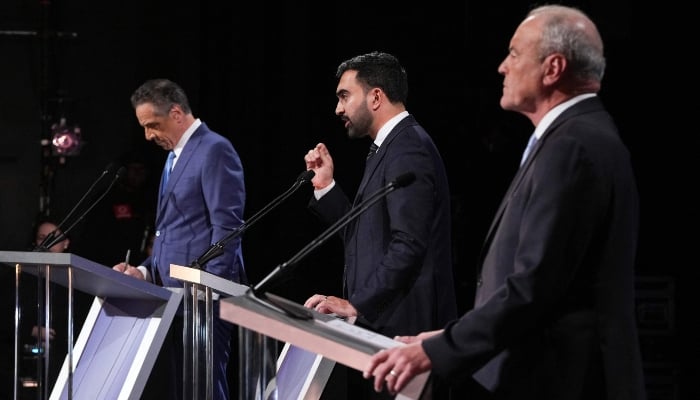
His platform also includes higher taxes on the city’s wealthiest, raising corporation tax and expanding affordable housing.
Andrew Cuomo, 67, is running as an independent after losing the Democratic primary to Mamdani. The former governor, who resigned four years ago amid sexual harassment allegations, has centred his campaign on public safety, pledging 5,000 additional New York Police Department (NYPD) officers and a crackdown on nuisance and quality-of-life offences.
Trump, who has labelled Mamdani a “communist”, effectively endorsed Cuomo in an interview on Sunday, and billionaire backers have urged Sliwa to step aside to consolidate the anti-Mamdani vote. Elon Musk also endorsed Cuomo on Monday.
Curtis Sliwa, 71, is the Republican candidate. His law-and-order message, vows to cut bureaucracy, and plans to boost investment outside affluent Manhattan have struggled to gain traction in polling.
Al Jazeera notes that some five million registered voters are set to cast ballots on November 4 to choose the city’s next leader.
-

 Tech7 days ago
Tech7 days agoOpenAI says a million ChatGPT users talk about suicide
-

 Tech7 days ago
Tech7 days agoHow digital technologies can support a circular economy
-

 Tech6 days ago
Tech6 days agoUS Ralph Lauren partners with Microsoft for AI shopping experience
-

 Tech6 days ago
Tech6 days agoAI chatbots are becoming everyday tools for mundane tasks, use data shows
-

 Fashion1 week ago
Fashion1 week agoTaiwan Textile Select showcases sustainable innovation at TITAS 2025
-

 Fashion7 days ago
Fashion7 days agoITMF elects new board at 2025 Yogyakarta conference
-

 Fashion1 week ago
Fashion1 week agoJapan’s textile trade shows strong apparel demand, weak yarn imports
-

 Business7 days ago
Business7 days agoTransfer test: Children from Belfast low income families to be given free tuition






